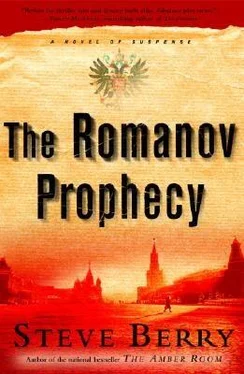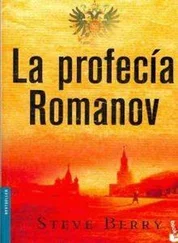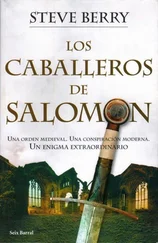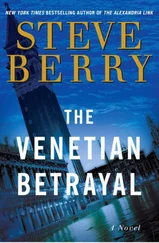Steve Berry - The Romanov Prophecy
Здесь есть возможность читать онлайн «Steve Berry - The Romanov Prophecy» весь текст электронной книги совершенно бесплатно (целиком полную версию без сокращений). В некоторых случаях можно слушать аудио, скачать через торрент в формате fb2 и присутствует краткое содержание. Жанр: Триллер, на английском языке. Описание произведения, (предисловие) а так же отзывы посетителей доступны на портале библиотеки ЛибКат.
- Название:The Romanov Prophecy
- Автор:
- Жанр:
- Год:неизвестен
- ISBN:нет данных
- Рейтинг книги:4 / 5. Голосов: 1
-
Избранное:Добавить в избранное
- Отзывы:
-
Ваша оценка:
- 80
- 1
- 2
- 3
- 4
- 5
The Romanov Prophecy: краткое содержание, описание и аннотация
Предлагаем к чтению аннотацию, описание, краткое содержание или предисловие (зависит от того, что написал сам автор книги «The Romanov Prophecy»). Если вы не нашли необходимую информацию о книге — напишите в комментариях, мы постараемся отыскать её.
The Romanov Prophecy — читать онлайн бесплатно полную книгу (весь текст) целиком
Ниже представлен текст книги, разбитый по страницам. Система сохранения места последней прочитанной страницы, позволяет с удобством читать онлайн бесплатно книгу «The Romanov Prophecy», без необходимости каждый раз заново искать на чём Вы остановились. Поставьте закладку, и сможете в любой момент перейти на страницу, на которой закончили чтение.
Интервал:
Закладка:
Metal clanked as the iron grille at the far end of the chamber opened. He glanced around a row of silver boxes and saw James strolling toward them. He quickly rebagged the egg and pulled the leather straps tight. The gold bars were still in their bag.
"Everything okay?" the man asked as he approached.
"Just fine," he said. "Would you perhaps have a cardboard box or paper bag we could use to transport these items?"
The man gave the table a quick perusal. "Of course, Mr. Lord. The bank is at your disposal."
Lord wanted to examine the rest of the box's contents but thought it wise to first leave the bank. Randall Maddox James was a bit too inquisitive for his current paranoid personality. But it was an understandable paranoia, he kept telling himself, considering what he'd endured the past few days.
He carried their new possessions in a Commerce amp; Merchants Bank paper bag with rope handles and led Akilina outside, where they took a cab to the public library. He recalled the building from a previous visit, a regal three-story structure of late-nineteenth-century design that had survived both the 1906 and 1989 earthquakes. A newer building stood next door, and they were directed there by a woman at an information desk. Before turning his attention back to the items in the bag, Lord located some books on Faberge, including one that cataloged all known imperial Easter eggs.
Inside a study room with the door locked, he spread the contents from the safe-deposit box on a table. He then opened one of the books and learned that fifty-six eggs had been created, starting in 1885 when Tsar Alexander III commissioned Carl Faberge to fashion for his wife, Empress Marie, a gift for Easter. That holy day was the most important feast of the Russian Orthodox Church, traditionally celebrated with an exchange of eggs and three kisses. The trinket was so well received that the tsar commissioned one every Easter thereafter. Nicholas II, Alexander's son who assumed the throne in 1894, continued the tradition, except that two were now crafted-one for his wife, Alexandra, and one for his mother.
Each of the unique creations, all of enameled gold and jewels, contained a surprise-a tiny coronation coach, a replica of the royal yacht, a train, windup animals, or some other intricate mechanical miniature. Forty-seven of the original fifty-six eggs were known to exist, their locations noted in captions beneath the photos. The remaining nine had never been located after the Bolshevik revolution.
He found a full-page photo of the Lilies of the Valley Egg. The caption beneath read:
Workmaster Michael Perchin of the Faberge workshop created this marvel. Its surprise is three miniature portraits of the tsar and Grand Duchesses Olga and Tatiana, the first two imperial children. Presently part of a private collection, New York.
The volume showed a color photo of the egg in nearly full size. A trefoil of portrait miniatures fanned from the top, the diamond crown with ruby above. Each photographic oval was gold-backed and framed in rose diamonds. The center photo showed Nicholas II in uniform, his bearded face, shoulders, and upper chest clearly visible. To his left was Olga, the firstborn, her angelic three-year-old face surrounded by curly blond hair. To the right was the infant Tatiana, not yet a year old. The back of each photo was engraved: APRIL 5, 1898.
He held up the egg from the safe-deposit box beside the picture. "These two are identical."
"But ours has no photos," Akilina said.
He glanced back at the book and read a little of the text, learning that a geared mechanism allowed the picture fan to rise. A gold-mounted pearl button on the side, when turned, supposedly activated the crank.
He studied the egg from the safe-deposit box and saw a gold-mounted pearl button. He tabled the legs and held the egg steady as he turned the tiny knob. Slowly, the diamond-studded crown rose. Beneath, a photo of Nicholas II appeared, the image identical to the one from the other Lilies of the Valley Egg pictured in the book. Then two more tiny oval photos fanned out, the left face male, the right female.
The knob would turn no farther and he stopped.
He stared at the pictures and recognized both faces. One was Alexie-the other, Anastasia. He reached over to one of the books and thumbed through it until he located a photo taken of the imperial children in 1916, before their captivity. He was right on their identity, but the faces from the egg were definitely older, both dressed in distinctive Western clothes, the tsarevich in what appeared to be a flannel shirt, Anastasia in a light-colored blouse. Behind each gold-and-diamond oval was the engraving: APRIL 5, 1920.
"They're older," he said. "They survived."
He reached for the newspaper and unfolded the yellowed bundle. He could read Swiss-German reasonably well and noticed a story on the bottom fold, apparently the reason why it had been included in the safe-deposit box. The article was headlined: GOLDSMITH FABERGE SUCCUMBS. The text reiterated the death of Carl Faberge the day before at the Hotel Bellevue in Lusanne. He'd only recently arrived from Germany, where he'd fled in exile after the Bolshevik takeover in October 1917. The story went on and noted that the House of Faberge, which Carl Faberge had headed for forty-seven years, ended with the demise of the Romanovs. The Soviets had seized everything and closed the business, though a vain attempt was made to keep the enterprise open for a short while under the more politically correct name of "Committee of the Employees of the Faberge Company." The reporter noted that the lack of imperial patronage was not the only reason for the business's decline. The First World War had tapped the resources of most of the rich clientele Faberge had served. The article concluded with an observation that privileged Russian society seemed gone forever. The photograph that accompanied the article showed Faberge as a broken man.
"This newspaper is here to prove authenticity," he said.
He rolled the egg over and found the goldsmith mark of the man who crafted it: HW. He thumbed through one of the volumes and came to a section that dealt with the various workmasters Faberge had employed. He knew that Faberge himself actually designed and made nothing. He was the presiding genius of a conglomerate that, at its height, produced some of the finest jewelry ever crafted, but it was the workmasters who actually conceived and assembled everything. The book noted that Michael Perchin, the head workmaster who created the Lilies of the Valley Egg, died in 1903. The text reflected that Henrik Wigstrom took over the managerial reigns until the House's demise, dying himself in 1923, a year before Faberge. The volume likewise contained a photograph of Wigstrom's mark-HW-and Lord compared the picture with the initials stamped into the bottom of the egg.
They were identical.
He saw that Akilina held the contents of the third velvet bag-another gold sheet with engraved writing in Cyrillic. He came close and had to strain to read it, but was able to translate:
To the Raven and the Eagle: This country has proven the haven it claims to be. The blood of the imperial body is safe, awaiting your arrival. The tsar reigns but does not govern. You must remedy that. The rightful heirs will remain forever silent until you properly awaken their spirit. What I wish for the despots who destroyed our nation Radishchev said best more than a hundred years ago: "No you shan't be forgotten. Damned for ages to come. Blood in your cradle, hymns and the battle roar. Ah, drenched in blood you tumble into the grave." See to it.
F. Y.
"That's it?" he said. "This tells us nothing. What about Hell's Bell? The last engraving from Maks's grave said only Hell's Bell can point the way to the next portal. There's nothing here about any Hell's Bell." He lifted the egg and shook it. Solid. No sound from inside. He carefully studied the exterior and noticed no lines or openings. "Obviously, we're supposed to know more at this point than we do. Pashenko said parts of the secret had been lost with time. Maybe there was another step we missed, one that would tell us what Hell's Bell is."
Читать дальшеИнтервал:
Закладка:
Похожие книги на «The Romanov Prophecy»
Представляем Вашему вниманию похожие книги на «The Romanov Prophecy» списком для выбора. Мы отобрали схожую по названию и смыслу литературу в надежде предоставить читателям больше вариантов отыскать новые, интересные, ещё непрочитанные произведения.
Обсуждение, отзывы о книге «The Romanov Prophecy» и просто собственные мнения читателей. Оставьте ваши комментарии, напишите, что Вы думаете о произведении, его смысле или главных героях. Укажите что конкретно понравилось, а что нет, и почему Вы так считаете.











